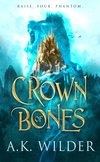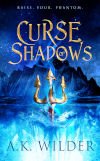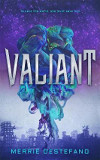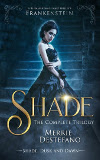.
#YoW Year of Worldbuilding
#WiF Worldbuilding in Fantasy
Worldbuilding lies at the heart of Fantasy fiction, which is why I've declared 2020 my Year of Worldbuilding in Fantasy and
started at my personal beginning last month, with CS Lewis's The Lion, the Witch, & the Wardrobe.
.
In the introduction, I promised that through this year I would continue to focus
on some (but by no means all -- the year isn't long enough for that!) of my personal favorites. I'm also hoping to shift between older and newer works and to look at more than one subgenre of fantasy – and also style of worldbuilding.
While this remains my intention, for this second post I am going to stay with an older work, which is also an Alternate World (aka Secondary World) fantasy, because when it comes to Fantasy literature and worldbuilding I just
can't go past Ursula Le Guin's
Earthsea.
Firstly, because Earthsea is a fabulous world (imho!) The other, main reason is because as a young but already avid Fantasy reader, Earthsea was the second really formative work in shaping my appreciation and love of worldbuilding. I had read other works between
The Lion, the Witch, & the Wardrobe and
A Wizard of Earthsea, but Earthsea stood apart from the rest.
I believe this is quite a tribute to Earthsea and Le Guin, since as Narnia was the first real fantasy novel I encountered it was always likely to have a big impact. As aforesaid, I had a far greater exposure to the genre by the time I picked up
A Wizard of Earthsea – but it still blew me away.
Spellbinding
Being a poet as well as a novelist, it's perhaps not surprising that
A Wizard of Earthsea began
casting its spell from the moment I read the poem that prefaces the (fascinating!) map and the first chapter:
Only in silence the word,
only in dark the light,
only in dying life:
bright the hawk's flight
on the empty sky.
I was going to say that the poem, haiku-like in its simplicity (although
not a haiku) prefaced the opening lines – but as soon as I shaped that thought I realized that the poem itself constitutes the opening lines. It captures, and encapsulates so much of the Earthsea world, which at first glimpse appears equally small: a scattering if islands amid an immensity of ocean that like the white space of the page, stretches beyond knowledge.
Earthsea is also a world of profound juxtapositions, beginning with the small footholds of land amid the sea, but including the comparative smallness of people and their lives against the physical immensity and longevity of the world's only other sentient beings, the dragons. It's also a world in which nature has a profound influence, not just because of the dominance of sea over land, but because it lies at the heart of the magic that wizards learn and practice. And in which the most significant juxtaposition is that in learning magic, the mage comes to understand the importance of not using it lightly.
All this is pointed to, and hinted at by the poem, but perhaps its greatest significance in terms of worldbuilding lies in stamping an atmospheric impression of the world on the reader. This occurs before we come to the map, with its visual depiction of "the world", and subsequently the story. Moreover, it's almost invisible, something I imagine few dwell on in their haste to get to that story – and yet it has a resonance that is already shaping our view of the world we are about to enter.
With
The Lion, the Witch, & the Wardrobe I discussed how Lewis draws us into his world gradually, matching our experiene to Lucy's as she progresses through the wardrobe and into the snowy wood. In
A Wizard of Earthsea, even leaving aside the poem, we're into the world from sentence one:
"The island of Gont, a single mountain that lifts its peak a mile above the storm-wracked Northeast Sea, is a land famous for wizards."
Where the poem has conveyed the spirit of the world, this single sentence grounds the reader and the story in its physical reality of (an) island and ocean, but also makes it clear that in this world, magic is real. The next few sentences go on to give a sense of historical context and depth to those qualities, as well as "placing" the main character, Ged, within the world that has been so instantly invoked.
The first chapter layers considerably more physical and contextual depth on the opening brushstrokes that established the world of islands and ocean, wizards and magic. The reader learns something of the nature of that magic, i.e. of language and naming, innate power and taught knowledge, as well as the nature of the world: a preindustrialized village-based society in which warfare is not common, but does occur.
As with Lucy in Narnia, the main character, initially called Duny but who becomes Ged, is the reader's window into that expanding knowledge. Unlike Lucy, Ged is born into Earthsea, he doesn't cross into it from our world, which is another reason for immersing the reader in the world from the outset.
Despite the story taking place entirely within the alternate world, and learning from Sentence One, Chapter One, that wizards are part of Earthsea, I believe the worldbuilding feels less "magical" and more "real." In Narnia, we share Lucy's wonder at her transition into a new world peopled by magical beings and talking animals. Whereas in Earthsea the reader is immersed in Ged's childhood reality: from the harshness of village existence, the excitement of magic and the allure of its power to a young boy, and the terror of warrior raiding parties.
Very different worlds and approaches, but both very skilful and compelling, as well as influential examples of Fantasy worldbuilding.
.
---
Next Month: I'm still pondering the next installment, so watch this space, but at present my ponderings are honing in a more recent work – and maybe one set in this world as well.
Meanwhile, let's all be careful out there and look out for each other.
---
Helen Lowe is a teller of tales and purveyor of story, chiefly by way of novels and poetry. Her first novel, Thornspell (Knopf), was published to critical praise in 2008. The second,The Heir of Night (The Wall Of Night Series, Book One) won the Gemmell Morningstar Award 2012, and the sequel, The Gathering Of The Lost, was shortlisted for the Gemmell Legend Award in 2013. Daughter Of Blood
(Book Three), was published in 2016 and Helen is currently completing
the final novel in the series. She posts regularly on her “…on Anything, Really” blog, monthly on the Supernatural Underground, and is also on Twitter: @helenl0we.





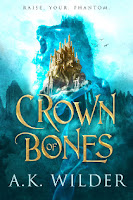 I write YA Lit for young adults, and the young at heart.
I write YA Lit for young adults, and the young at heart.























